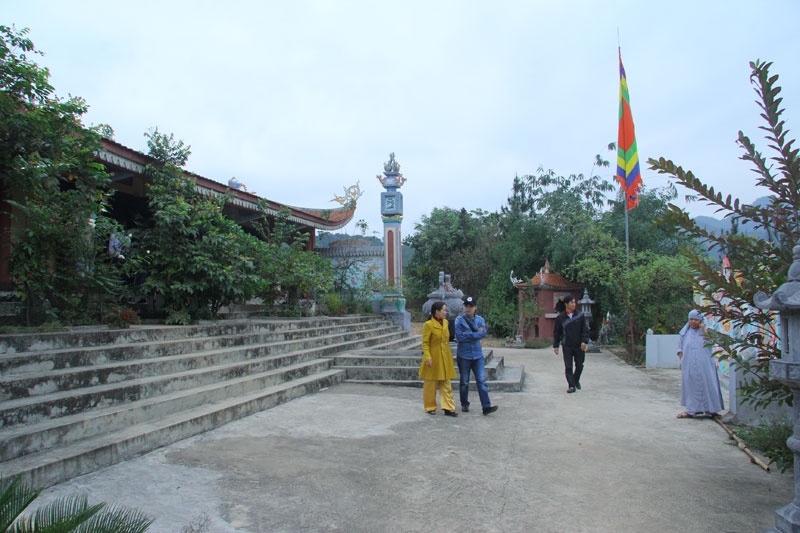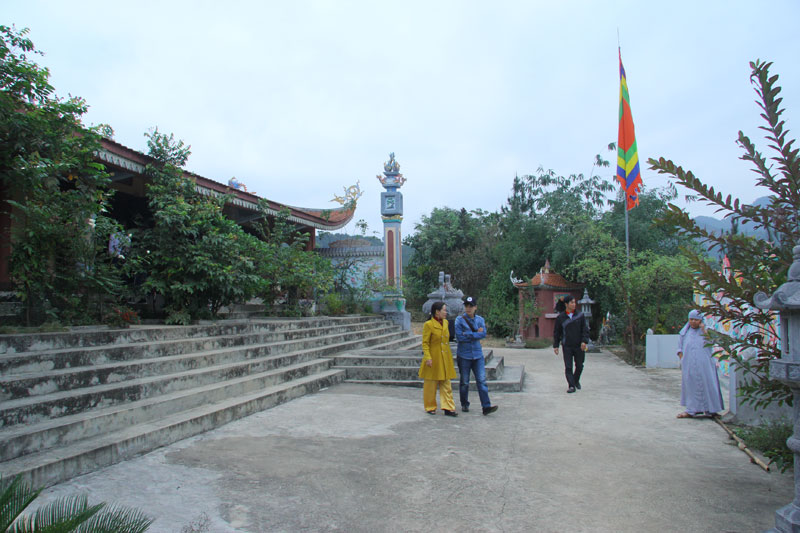
(HBO) - Doi Co Cua Chuong Temple in Hien Luong Commune (Da Bac) is a spiritual tourist destination in the tourism journey within Hoa Binh Lake. It is currently a tourist attraction attracting a lot of tourists inside and outside the province.

Doi Co Temple.
Doi Co Temple was established at Chuong port to worship the female retainers of Mrs. Dinh Thi Van, who had helped Le Loi King fight the enemy. The temple is located on the top of Bo hill in Mo hamlet, Hien Luong commune about 100 m far from the old Hai Co temple, facing the Southeast. The temple has an area of about 500 square meters, designed with 3 compartments and 2 wings, including Dai Bai and Hau Cung buildings with curved roof heads, 4 roof corners are covered with embossed phoenix, the banks of the top are covered with embossed dragons flanking moon, making of solid concrete.
The legend says that in 1431, Le Loi King took tens of thousands of troops along Da River to attack Deo Cat Han over this place. Ms. Dinh Thi Van - the daughter of Lang Muong with the two maids called for young men in the area to join hands, helping the army of Le Loi King to overcome Bo Falls to fight the enemy. The young men cut wood to make canoes, cut bamboo and great bamboo to make rafts to bring troops across the river, whole the women collected rice, and supplies for the army of Le Loi King.
With the help of the people around the region, the army led by Le Loi King defeated Deo Cat Han enemy in Muong Le (Son La). After winning the battle, he came back to Bo Falls and he asked his army to level and set up a camp to celebrate the victory. The King used a stone sword engraved a poem recording the victories of the Muong army and people. Currently, Le Loi memorial stele is stored in Hang Than hill, Vua Nua commune (Da Bac) and it has become a historical and spiritual tourist destination on Hoa Binh lake.
The joy of victory of the army was not complete, it was reported that the boat of Mrs. Dinh Thi Van and her two servants was sunk by heavy rain and strong wind on the way to come back. Le Loi King immediately issued the orders to the army and people along the two sides of the Da river to search, and if their bodies were found anywhere, they would be buried there, and a temple would be set up to pay their tribute at the same time. After a few days, the body of Mrs. Dinh Thi Van drifted into the waterfall forest (i.e the Bo waterfall), the people there buried and set up the temple of Mrs. Dinh Thi Van. Le Loi King presented Dinh Thi Van with the title of Lady of Bo Lord. The bodies of the two maids drifted to Ben Chuong, belonging to Hien Luong commune and were buried by the people and built a temple at Ben Chuong. With a sorrowful heart for the country at the full moon age, the King established a temple and awarded the title of the Doi Co Cua Chuong temple.
Every year from the 7th to the 9th of the first lunar month, the people here hold a festival to commemorate the merit of the Lady of Bo Lord and her two servant girls, praying for the good rain and harvest, the health of people, and happy and peaceful villages. After the ceremony, the festival is organized with a number of folk games such as: Dum singing, Xoe dancing, swinging and throwing cotton ball games... Currently, Doi Co Cua Chuong temple is the destination of the people in the region and tourists attending the festival, worshiping and sightseeing.
Located just a 20-minute drive from Hoa Binh City, Ora Hill Farmstay & Glamping Hoa Binh is a captivating new destination nestled in Mo hamlet, Bình Thanh commune, Cao Phong district. Combining farming with leisure, this tranquil retreat is perfect for those seeking balance, joy, and an immersive experience in the expansive beauty of nature.
Muong Bi - Tan Lac is renowned as one of the four famous Muong regions in Hoa Binh province. Blessed by nature with a favourable climate and stunning landscapes, Tan Lac holds great advantages for tourism development. The local tourism industry has made remarkable strides in recent times thanks to the attention and support from the local authorities and sectors.
With its strategic location, well-developed transport network, and diverse soil and climatic conditions, Hoa Binh is emerging as a must-visit destination in Vietnam's northwestern tourism corridor. The province boasts numerous attractions, including the Kim Boi hot springs (Kim Boi district), the Dau Rong cave complex (Cao Phong), the Mai Chau valley (Mai Chau), and the iconic Hoa Binh hydropower plant.
The northern mountainous province of Hoa Binh has been listed among the 71 most beautiful places to visit worldwide by the prestigious US travel magazine Condé Nast Traveller.
Hoa Binh province’s rich natural and cultural resources position it as a prime location for developing community-based tourism (CBT). In recent years, support from central and provincial policies, as well as assistance from non-governmental organisations, have encouraged local ethnic minority and mountainous communities to actively engage in the sector.



